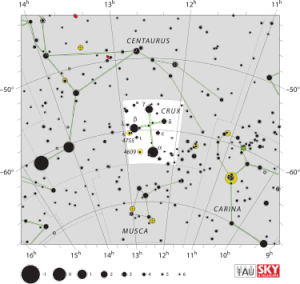Crux
Crux located in the deep southern sky, is the smallest yet one of the most distinctive of the 88 modern constellations. Its name is Latin for cross, and it is dominated by a cross-shaped asterism that is commonly known as theSouthern Cross. Although visible to the Ancient Greeks, it was seen as part of the constellation Centaurus, and not defined or accurately mapped till the 16th century. Known as Acrux, blue-white Alpha Crucis is the constellation's brightest star and the bottom star of the cross. Nearly as bright are Beta and Gamma, while Delta and Epsilon make up the asterism. Many of the constellation's brighter stars are members of the Scorpius–Centaurus Association, a loose group of hot blue-white stars that appear to share a common origin and motion across the Milky Way. Two star systems have been found to have planets. The constellation also contains four Cepheid variables visible to the naked eye under optimum conditions. Crux also contains the Jewel Box, a bright open cluster, and the Coalsack Nebula, the most prominent dark nebula in the sky. Crux is bordered by the constellations Centaurus (which surrounds it on three sides) on the east, north and west, and Musca to the south. Covering 68 square degrees and 0.165% of the night sky, it is the smallest of the 88 constellations.
Crux was visible to the Ancient Greeks; Ptolemy regarded it as part of the constellation Centaurus. It was entirely visible as far north as Britain in the fourth millennium BC. However, the precession of the equinoxes gradually lowered its stars below the European horizon, and they were eventually forgotten by the inhabitants of northern latitudes. By AD 400, most of the constellation never rose above the horizon for Athenians. [1]
HGS Session References
HGS Sessions - Clearing Hyperspace Phantom Matrix - 3/12/2015 [2]HGS Sessions - Clearing Macau Island, China - 3/21/2015 [3]
References
Found in HGS Manual on Page 108
Found in HGS Manual on Page 115
